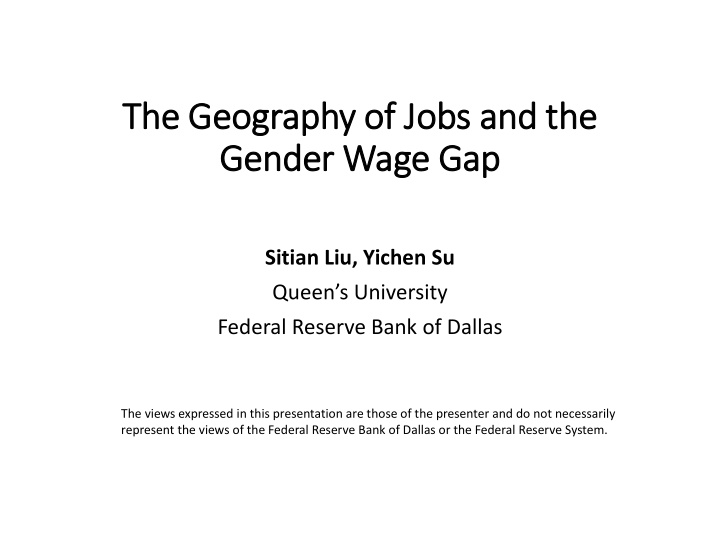



The The Geography o of Jobs and t and the he Ge Gende nder W Wage Ga Gap Sitian Liu, Yichen Su Queen’s University Federal Reserve Bank of Dallas The views expressed in this presentation are those of the presenter and do not necessarily represent the views of the Federal Reserve Bank of Dallas or the Federal Reserve System.
Ge Gender er wage g e gap • Convergence of gender wage gap (Blau and Kahn, 2017) • Human capital gap (education, experience, etc.) • Discrimination • Unexplained gap persists • Preferences for non-pay job attributes => compensating differential (Goldin, 2014) (Wiswall et al., 2014, 2017) (Gutierrez, 2018), (Le Barbanchon et al., 2019) • Temporal flexibility • Occupations and industries • Commuting friction This paper
Log w wag age g gap a and l log c commuting gap ( (residual al) Raw gap Preview : • Large geographic variation in commuting friction due to the geography of jobs • Commuting friction accounts for 17-20% of the remaining gender wage gap (preliminary)
Job Choice Model Empirical Evidence Estimating the Model Decomposition Analysis
Job Choice Model Empirical Evidence Estimating the Model Decomposition Analysis
Job ob choi oice m mod odel (1/3) • Workers maximize following Differ by gender • Job choice frontier- maximum wage attainable within commuting time τ Return to commuting
Job ob choi oice m mod odel (2/3)
Job choice m model (3/ 3/3) – smalle ller β
Model el p pred ediction • Gender gap in commuting time and wage larger for workers living far from high-wage jobs (relative to low-wage jobs). • Workers living far from city centers should see larger wage and commuting gaps. • Gaps should vary more spatially for occupations in which high-wage jobs are geographically concentrated. • Wage gap should be correlated with commuting gap.
Job Choice Model Empirical Evidence Estimating the Model Decomposition Analysis
Data • American Community Survey (2013-2017) Cross-sectional earnings, hours worked and commuting time • Rich set of demographic variables: sex, age, marital status, children, • education. PUMA (Public Use Microdata Areas) geocode for each worker. • Log commute gap Log wage gap (NY MSA) (NY MSA)
Empirical e evidence ( (1/3): G Gen ender gaps lar arger far arth ther from om c city c centers Log wage gap Residual log wage gap Log commuting gap Residual log commuting gap
Empirical e evidence ( (2/3): w wage g gap is high ghly correl elated w with c commuting g g gap • Commuting gap can explain a portion of the gender wage gap • Gender wage gap is slightly lower in places with no commuting gap. (0.1079 to ~0.0893 – around 17%) Residual log wage gap vs. Log wage gap vs. log commuting gap residual log commuting gap
Empirical e evidence ( (3/3): Co Commuting g gap u unlik likely ly driv iven by spatial s l sortin ing • Management professional jobs are highly centralized • Healthcare practitioner jobs much more decentralized • Spatial sorting not likely drives commuting gap Healthcare practitioners Management and professional jobs
Job Choice Model Empirical Evidence Estimating the Model Decomposition Analysis
Estimating g the I e Indifferen ence c e curve • American Community Survey 2013-2017 • Under perfect mobility, utility U equal everywhere • Regress ln( w ) on τ yield unbiased estimate of λ • Simple cross-sectional regression yield biased results 1. Location sorting by ability (demo) 2. Random job arrival (demo) • Identify the slope of reservation utility curve • Slope of the lower boundary of observed (ln( w ), τ ): (ln( w R ), τ R ) • Estimator must be robust to outliers and measurement errors • • 0.01 quantile regression on residualized (ln( w ), τ ) (simulation)
Indifferen ence c curve: R Res esults
Mea easuring t g the e Job c choice s set f frontier • Simulate spatial distribution of jobs with wages for each occupation and residential PUMA • Mean and sd of residual wages - ACS 2013-2017 Place-of-Work PUMA (PWPUMA) • Zip Code Business Patterns (zip code level job count) • Google distance API • Frontier estimator (Cazals et al. 2002) to pin down β (estimator) Financial manager – Northern suburbs, NY Financial manager – Midtown Manhattan, NY
Job ob choi oice s set f t fron onti tier: Results ts β distribution β wrt. distance to downtown β wrt. distance to downtown (Financial manager vs. physicians)
Job Choice Model Empirical Evidence Estimating the Model Decomposition Analysis
Model el p pred ediction v vs. d data • Predicted log wage gap is 0.01386 log gap (0.07038 actual gap) – 19.69% • Predicted log commuting gap is 0.03365 log gap (0.0243 actual gap) – 138%
Co Counterf rfactual: i increa easing g travel s speed eed • Reduce commuting time • Re- compute β Two effects • Smooth existing trade-off ( β ↓) • Jobs previously too far may enter trade-off ( β ↑ ) • Nonlinear
Co Conclusion • We analyze the role of commuting friction in the remaining gender wage gap • Use a job choice model to illustrate that differential preferences for commuting and returns to commuting lead to wage differentials between genders • Strong empirical support in the data • Estimate the model: the indifference curve and job choice frontier • Commuting friction explains a portion (17-20%) of the gender wage gap (preliminary)
Appendix
Lo Log w wage g gap ap an and l log c commutin ing gap ap back
Sort rting b by a abi bility back
Ran andom job a arrival back
Identi tificati tion on ( (1/ 1/2) back
Identi tificati tion on ( (2/ 2/2) back
Frontier e estimat ator • Cazals et al. (2002) • M=500 • n(τ) is the number of observations less than τ • Robust to outliers • Estimate the maximum log wage within certain log commuting time threshold back
Recommend
More recommend